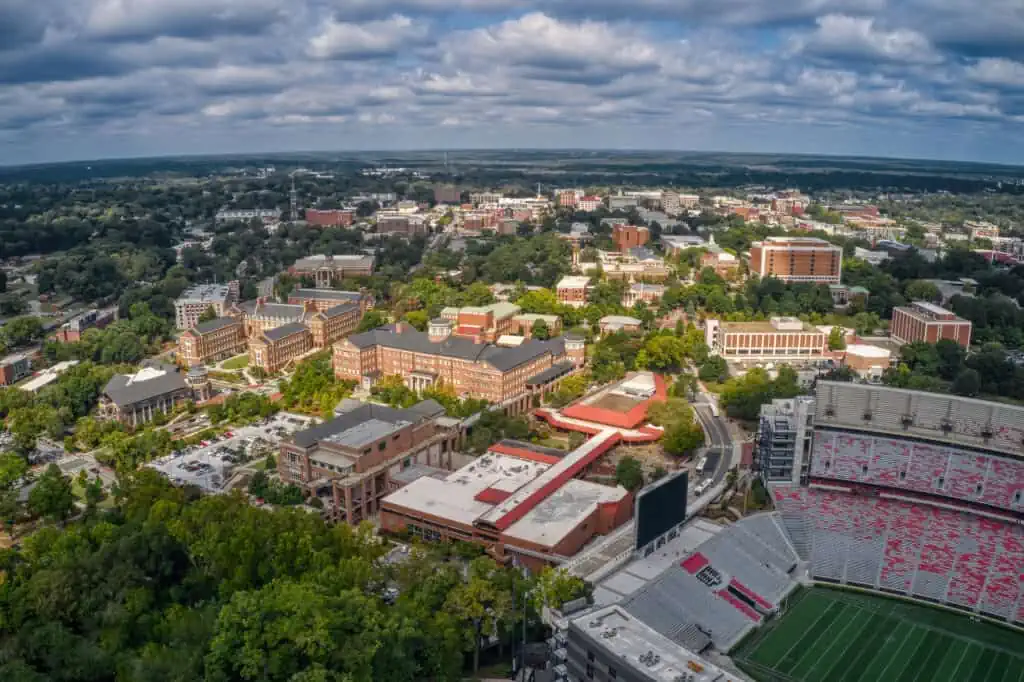Key Findings
- The average price of a home in a college town in 2023 is $377,800, 7% lower than the national average of ($406,200), according to Redfin
- Homes in college towns have appreciated by 4% in the last 12 months, compared to a 1.6% growth rate in home prices across the United States
- The best college town for real estate investment is Indiana, PA due to relatively low home prices ($160k), their solid projected growth (+12%), and potentially high rental income
- Gary, IN is the least expensive college town in the United States with an average home costing around $71,000 in 2023
- Among college towns, Athens, GA is the hardest real estate market to get into, with an average home price of $355,400 and 64 new listings over 100 home sales
As a new crop of college students start class this September, the cost of attending college has never been higher. At four-year colleges, room and board alone costs around $12,000 to $13,000 per year.
That cost is pushing some parents towards buying a home close to their child’s college campus — even if the school might be far away. Renting in college towns remains expensive, but buying a home and renting out part of it could help cover mortgage repayments and so long as prices keep appreciating, it can be a good investment.
In this study, we rank over 500 college towns on their real estate investment potential based on current home prices, historical and projected growth, housing availability, and potential rental income. Read on to see which college towns score the highest, and where you might want to consider making your new home.
Prospects of Prosperity: Best College Towns for Real Estate Investment

This was our approach to ranking the 580 college towns on the following real estate metrics:
- Median home price (the lower, the better)
- Price change in the last 12 months (the more it’s grown, the better)
- Projected growth in home prices over the next five years (the higher, the better)
- Favorable housing supply-to-demand ratio (the more new listings for every home sold, the better)
- Potential rental income (the higher the average rent in the town, the better)
On the balance of these factors, the college town with the best potential for real estate investments is Indiana, PA, scoring 93 out of 100 on our combined scale.
Home to the Indiana University of Pennsylvania, this town’s home prices average around $160,500 in 2023. Home prices grew 19% in the last 12 months and are projected to grow by 12% more over the next five years. Combined with high levels of housing supply and a potentially high rental income, these factors put Indiana, PA in the #1 spot in our ranking.
“The most affordable college towns are largely concentrated in the Midwest, with 7 out of 10 being either in Illinois or Indiana.”
McPherson, KS is in second place, with house prices slightly higher ($179,800) and recent growth slightly slower (14% year-over-year). Two more towns from Kansas made our top 10 — Winfield, KS (#5), and Atchison, KS (#10), both with a median home price of around $150,00 and a healthy supply of homes for sale.
Geographically, the 10 highest-ranked towns stretch across the eastern part of the US. The furthest south is Brownwood, TX (#3) where homes are expected to appreciate 20% over the next five years. In the north, there’s Williamsport, PA (#6), where a typical home costs $136,800.
Explore our interactive map below to see what other towns made our top 10.
Here are the top 10 college towns in ranking order:
| Rank | Town | Total Score |
| 1 | Indiana, PA | 93.0 |
| 2 | McPherson, KS | 92.1 |
| 3 | Brownwood, TX | 88.8 |
| 4 | Arkadelphia, AR | 87.8 |
| 5 | Winfield, KS | 87.3 |
| 6 | Williamsport, PA | 86.8 |
| 7 | Clinton, SC | 86.6 |
| 8 | Murray, KY | 86.1 |
| 9 | Lubbock, TX | 86.0 |
| 10 | Atchison, KS | 85.7 |
To see where all 580 colleges we ranked are located, check out the full map below. You can also find the college town with the highest real estate investment potential in your state!
An A+ in Affordability: College Towns with Low-Cost Homes
Comparing college towns from a pure price standpoint, there’s no rivaling Gary, IN (#291) — home to Indiana University — where houses sold for a median price of $71,000 in 2023.
The most affordable college towns are largely concentrated in the Midwest, with 7 out of 10 being either in Illinois or Indiana. Notable among them are Marion, IL (#378) where homes are projected to appreciate 17% by 2028, and Pine Bluff, AR (#30) where the supply of homes is far greater than demand.
In 7 out of the 10 least expensive college towns, the median price of a home in 2023 is below $100,000.
Growing Strong: Top College Towns for Projected Home Value Growth
Overall, home value in college towns has grown by 4% in the last year — higher than the US average of 1.6%. Looking at home price dynamics in college towns, the clear winner is Rock Hill, SC (#217), where both Winthrop University and Clinton College are located. Here, home prices are poised to rise by 33% over the next five years — the highest among college towns in our dataset.
That said, homes in Rock Hill, SC are fairly expensive ($315,900), which makes towns like Mount Vernon, OH (#26), and Anderson, IN (#28) better investment prospects overall with homes priced at $195,400 and $142,300, respectively.
Another interesting entry on this top 10 list is Buffalo, NY (#85), where the projected 5-year price growth is at 27%, homes go for $183,00 and rents reach an average of $1,349.
Lock and Key: Hardest College Towns Real Estate Markets to Get Into
An increasing number of college-goers and their parents might be considering buying a home in a college town. But, much like with college admissions, getting into one might prove a trying task. In most college towns, the demand for homes far outstrips supply.
This is particularly true for Athens, GA (#316) — the home base of the University of Georgia. With only 64 new listings for every 100 home sales and most homes going off the market in only 24 days, buying a home in this college town can be incredibly tricky.
And no wonder! Homes there are valued 21% higher than they were last year and are projected to appreciate by another 7% by 2028.
The second toughest college town to break into is another town in Georgia — Valdosta, GA (#315). Homes here typically cost $180,900 but housing supply is dwindling fast. For every 100 homes sold, only 74 are listed and they usually get sold within 35 days.
“Homes in college towns have appreciated by 4% in the last 12 months, compared to a 1.6% growth rate in home prices across the United States”
Two Idaho towns are among those where housing availability is the most scarce — Nampa, ID (#555) and Caldwell, ID (#516). Even though homes here aren’t selling that fast (≈55-60 days), new listings are at a deficit compared to home sales.
Even though homes in these towns don’t come cheap ($401,300 and $366,300, respectively), rents are high ($1,500+) and in both towns, homes are projected to appreciate by more than 20% in the next five years.
See prices for local moving labor. Read real customer reviews. Easily book your help online.
Compare and Contrast: All College Towns, Mapped and Ranked
You can Browse all the college towns we analyzed along with their real estate data using the interactive table below.
Sources and Methodology
College towns were selected using the Integrated Postsecondary Education Data System (IPEDS) available via the National Center for Education Statistics (NCES). To be included in the ranking, a college town had to have at least one four-year institution, granting Bachelor-level degrees or higher, where 50% or more students were full-time.
College town population figures were looked up using the Census Bureau estimates. Places with a population of 500,000 or more were excluded.
The total “Best for Real Estate Investment” score has a maximum of 100 points and is based on a selection of six factors, which were weighted as follows:
-
-
Home Price (30 points) = Median home price in 2023
-
Home Price 12-Month Change (10 points) = Average percentage change in home price compared to 12 months ago
-
Market Projection (15 points) = Projected percent increase or decrease in home price in the next five years
-
Real Estate Availability (15 points) = Number of homes sold per 100 new listings
-
Days On The Market (10 points) = Median number of days a listing spent on the market in 2023
-
Rent (20 points) = Median rent of a residential property in 2023
-



 Even though home prices have been falling for the
Even though home prices have been falling for the